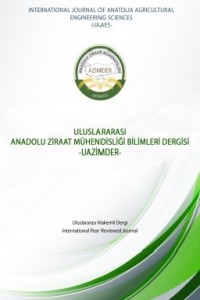Öz
The plant factory emerges as a concept that emerged in the 80s, integrated with technology, and given to isolated plant production systems despite significant environmental and environmental factors. Plant factories have contributed to the development of cities and increase crop diversity in economic growth. For example, a plant factory with 300,000 inhabitants in Bolu, where winters are harsh and capable of producing 20,000 head of curly salads per day (examples are available in the Netherlands, Japan and the USA) will be able to meet the curly salad requirement of the whole city. Moreover, daily and fresh, less cost-effective without being installed in other cities for circulation and storage, completely hygienic and does not require washing, longer shelf life, every day of the year with the same flavor standard, can be seen as a product that can reach year-round. However, the most precise determination and controllability / automation of the limiting cost elements requires a serious R & D investment.
Anahtar Kelimeler
Kaynakça
- Anonim, 2009. Global agriculture towards 2050, How to feed the world 2050. <http://www.fao.org /fileadmin/templates/ wsfs/docs/expert_ paper/How_to_Feed_the_World_ in_ 2050.pdf>.
- Hao, X., Zheng, J.M., Little, C., Khosla, S. 2012. LED inter-lighting in year-round greenhouse mini-cucumber production,” in Proceeding of the VII International Symposium on Light in Horticultural Systems 956, eds Acta Horticulturae (Cagliari: Acta Horticulturae), 335–340.
- Kozai, T., Niu, G. 2016. Plant factory as a resource-efficient closed plant production system. In: T. Kozai, G. Niu, M. Takagaki (Eds.): Plant Factory: An Indoor Vertical Farming System for Efficient Quality Food Production, Amsterdam: Elsevier. pp: 69–90.
Öz
Bitki fabrikası 80’li yıllarda ortaya çıkan, teknoloji ile bütünleşik, önemli ölçüde çevreye ve çevresel faktörlere karşın izole edilmiş bitki üretim sistemlerine verilen bir kavram olarak karşımıza çıkmaktadır. Bitki fabrikaları ekonomik büyümede kentlerin gelişmesine ve mahsul çeşitliliğinin artmasına katkı sağlamıştır. Örneğin, 300 bin nüfuslu, kışların sert geçtiği Bolu’da kurulabilecek ve günde 20 bin baş kıvırcık salata üretim kapasiteli bir bitki fabrikasında (örnekleri Hollanda, Japonya ve ABD’de mevcuttur) şehrin tamamının kıvırcık salata ihtiyacı karşılanabilecektir. Üstelik günlük ve taze, başka şehirden dolaşıma ve depolamaya takılmadan daha az maliyetli, tamamen hijyenik ve yıkama gerektirmeyen, daha uzun raf ömürlü, senenin her günü aynı lezzet standardında, yıl boyu ulaşabilir bir ürün olarak karşımıza çıkabilecektir. Fakat burada sınırlayıcı olan maliyet unsurlarının en net şekilde belirlenmesi ve kontrol edilebilirliği/otomasyonu ciddi bir Ar-Ge yatırımına ihtiyaç duymaktadır.
Anahtar Kelimeler
Kaynakça
- Anonim, 2009. Global agriculture towards 2050, How to feed the world 2050. <http://www.fao.org /fileadmin/templates/ wsfs/docs/expert_ paper/How_to_Feed_the_World_ in_ 2050.pdf>.
- Hao, X., Zheng, J.M., Little, C., Khosla, S. 2012. LED inter-lighting in year-round greenhouse mini-cucumber production,” in Proceeding of the VII International Symposium on Light in Horticultural Systems 956, eds Acta Horticulturae (Cagliari: Acta Horticulturae), 335–340.
- Kozai, T., Niu, G. 2016. Plant factory as a resource-efficient closed plant production system. In: T. Kozai, G. Niu, M. Takagaki (Eds.): Plant Factory: An Indoor Vertical Farming System for Efficient Quality Food Production, Amsterdam: Elsevier. pp: 69–90.
Ayrıntılar
| Birincil Dil | Türkçe |
|---|---|
| Konular | Ziraat Mühendisliği (Diğer) |
| Bölüm | Makaleler |
| Yazarlar | |
| Yayımlanma Tarihi | 27 Aralık 2019 |
| Gönderilme Tarihi | 18 Kasım 2019 |
| Yayımlandığı Sayı | Yıl 2019 Cilt: 1 Sayı: 5 |


